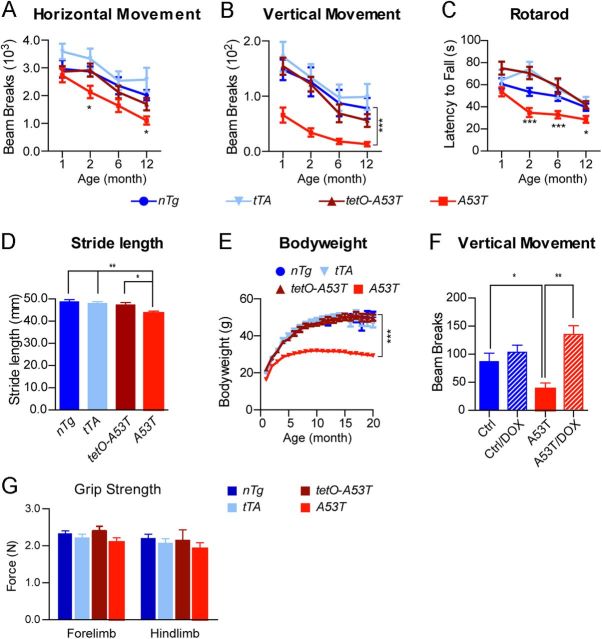Figure 3.
A53T α-syn inducible transgenic mice display profound motor disabilities. A, B, The horizontal movement (A) and vertical movement (B) of male A53T (n = 14) and control nTg (n = 12) mice as well as tetO-A53T (n = 13) and PITX3-IRES2-tTA (tTA; n = 13) single-transgenic mice were measured using the open-field test at 1, 2, 6, and 12 months of age. Data were presented as mean ± SEM. *p < 0.05; ***p < 0.001. C, The latency to fall was quantified by the rotarod test at 1, 2, 6, and 12 months of age for the same cohort of A53T and control mice used in A. Data were presented as mean ± SEM. *p < 0.05; ***p < 0.001. D, The stride length of 1-month-old male A53T and control mice (n ≥ 5 animals per genotype; n ≥ 20 strides per animal) was measured using the automatic TreadScan gait analysis system. Data were presented as mean ± SEM. *p < 0.05; **p < 0.01. E, Male A53T transgenic and control mice (n ≥ 10 animals per genotype) were weighed monthly for 20 months. Data were presented as mean ± SEM. ***p < 0.001. F, Vertical movements of 2-month-old A53T (n = 8) and control (Ctrl; including nTg, tTA, and tetO-A53T; n = 7) mice with regular chow compared with age-matched A53T (n = 6) and control (n = 5) mice with DOX-containing chow starting from earlier embryonic stages. Data were presented as mean ± SEM. *p < 0.05; **p < 0.01. G, The bar graph shows the grip strength of both the forelimb and hindlimb of 1-month-old male A53T (n = 10) and age-matched control nTg (n = 6) mice as well as tTA (n = 8) and tetO-A53T (n = 4) single-transgenic mice.

